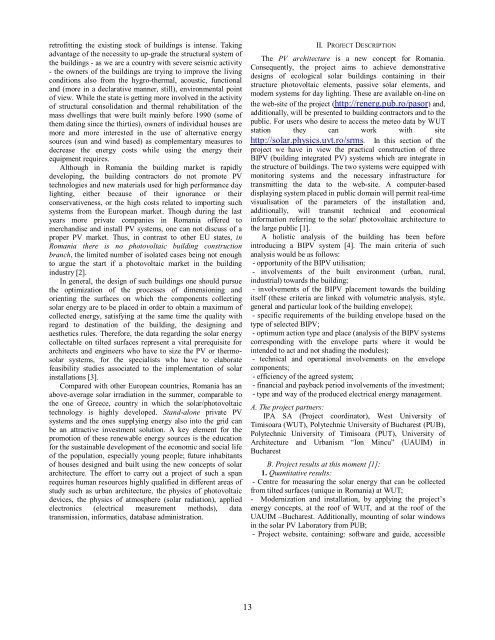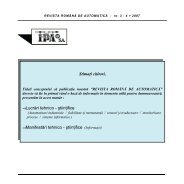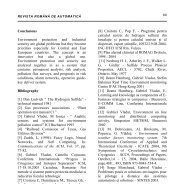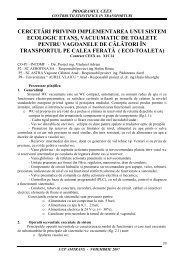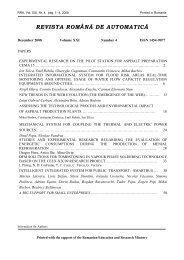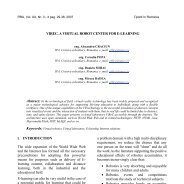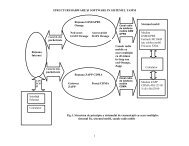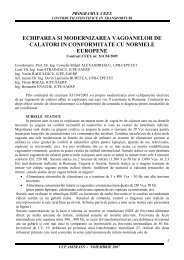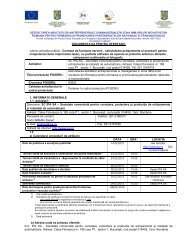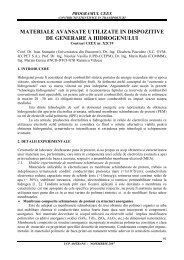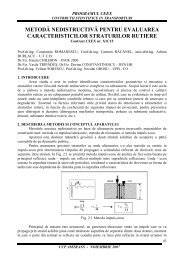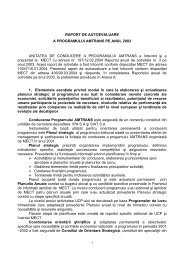0_ CUPRINS - IPA SA
0_ CUPRINS - IPA SA
0_ CUPRINS - IPA SA
Create successful ePaper yourself
Turn your PDF publications into a flip-book with our unique Google optimized e-Paper software.
etrofitting the existing stock of buildings is intense. Taking<br />
advantage of the necessity to up-grade the structural system of<br />
the buildings - as we are a country with severe seismic activity<br />
- the owners of the buildings are trying to improve the living<br />
conditions also from the hygro-thermal, acoustic, functional<br />
and (more in a declarative manner, still), environmental point<br />
of view. While the state is getting more involved in the activity<br />
of structural consolidation and thermal rehabilitation of the<br />
mass dwellings that were built mainly before 1990 (some of<br />
them dating since the thirties), owners of individual houses are<br />
more and more interested in the use of alternative energy<br />
sources (sun and wind based) as complementary measures to<br />
decrease the energy costs while using the energy their<br />
equipment requires.<br />
Although in Romania the building market is rapidly<br />
developing, the building contractors do not promote PV<br />
technologies and new materials used for high performance day<br />
lighting, either because of their ignorance or their<br />
conservativeness, or the high costs related to importing such<br />
systems from the European market. Though during the last<br />
years more private companies in Romania offered to<br />
merchandise and install PV systems, one can not discuss of a<br />
proper PV market. Thus, in contrast to other EU states, in<br />
Romania there is no photovoltaic building construction<br />
branch, the limited number of isolated cases being not enough<br />
to argue the start if a photovoltaic market in the building<br />
industry [2].<br />
In general, the design of such buildings one should pursue<br />
the optimization of the processes of dimensioning and<br />
orienting the surfaces on which the components collecting<br />
solar energy are to be placed in order to obtain a maximum of<br />
collected energy, satisfying at the same time the quality with<br />
regard to destination of the building, the designing and<br />
aesthetics rules. Therefore, the data regarding the solar energy<br />
collectable on tilted surfaces represent a vital prerequisite for<br />
architects and engineers who have to size the PV or thermosolar<br />
systems, for the specialists who have to elaborate<br />
feasibility studies associated to the implementation of solar<br />
installations [3].<br />
Compared with other European countries, Romania has an<br />
above-average solar irradiation in the summer, comparable to<br />
the one of Greece, country in which the solar/photovoltaic<br />
technology is highly developed. Stand-alone private PV<br />
systems and the ones supplying energy also into the grid can<br />
be an attractive investment solution. A key element for the<br />
promotion of these renewable energy sources is the education<br />
for the sustainable development of the economic and social life<br />
of the population, especially young people; future inhabitants<br />
of houses designed and built using the new concepts of solar<br />
architecture. The effort to carry out a project of such a span<br />
requires human resources highly qualified in different areas of<br />
study such as urban architecture, the physics of photovoltaic<br />
devices, the physics of atmosphere (solar radiation), applied<br />
electronics (electrical measurement methods), data<br />
transmission, informatics, database administration.<br />
II. PROJECT DESCRIPTION<br />
The PV architecture is a new concept for Romania.<br />
Consequently, the project aims to achieve demonstrative<br />
designs of ecological solar buildings containing in their<br />
structure photovoltaic elements, passive solar elements, and<br />
modern systems for day lighting. These are available on-line on<br />
the web-site of the project (http://renerg.pub.ro/pasor) and,<br />
additionally, will be presented to building contractors and to the<br />
public. For users who desire to access the meteo data by WUT<br />
station they can work with site<br />
http://solar.physics.uvt.ro/srms. In this section of the<br />
project we have in view the practical construction of three<br />
BIPV (building integrated PV) systems which are integrate in<br />
the structure of buildings. The two systems were equipped with<br />
monitoring systems and the necessary infrastructure for<br />
transmitting the data to the web-site. A computer-based<br />
displaying system placed in public domain will permit real-time<br />
visualisation of the parameters of the installation and,<br />
additionally, will transmit technical and economical<br />
information referring to the solar/ photovoltaic architecture to<br />
the large public [1].<br />
A holistic analysis of the building has been before<br />
introducing a BIPV system [4]. The main criteria of such<br />
analysis would be as follows:<br />
- opportunity of the BIPV utilisation;<br />
- involvements of the built environment (urban, rural,<br />
industrial) towards the building;<br />
- involvements of the BIPV placement towards the building<br />
itself (these criteria are linked with volumetric analysis, style,<br />
general and particular look of the building envelope);<br />
- specific requirements of the building envelope based on the<br />
type of selected BIPV;<br />
- optimum action type and place (analysis of the BIPV systems<br />
corresponding with the envelope parts where it would be<br />
intended to act and not shading the modules);<br />
- technical and operational involvements on the envelope<br />
components;<br />
- efficiency of the agreed system;<br />
- financial and payback period involvements of the investment;<br />
- type and way of the produced electrical energy management.<br />
A. The project partners:<br />
<strong>IPA</strong> <strong>SA</strong> (Project coordinator), West University of<br />
Timisoara (WUT), Polytechnic University of Bucharest (PUB),<br />
Polytechnic University of Timisoara (PUT), University of<br />
Architecture and Urbanism “Ion Mincu” (UAUIM) in<br />
Bucharest<br />
B. Project results at this moment [1]:<br />
1. Quantitative results:<br />
- Centre for measuring the solar energy that can be collected<br />
from tilted surfaces (unique in Romania) at WUT;<br />
- Modernization and installation, by applying the project’s<br />
energy concepts, at the roof of WUT, and at the roof of the<br />
UAUIM –Bucharest. Additionally, mounting of solar windows<br />
in the solar PV Laboratory from PUB;<br />
- Project website, containing: software and guide, accessible<br />
13


